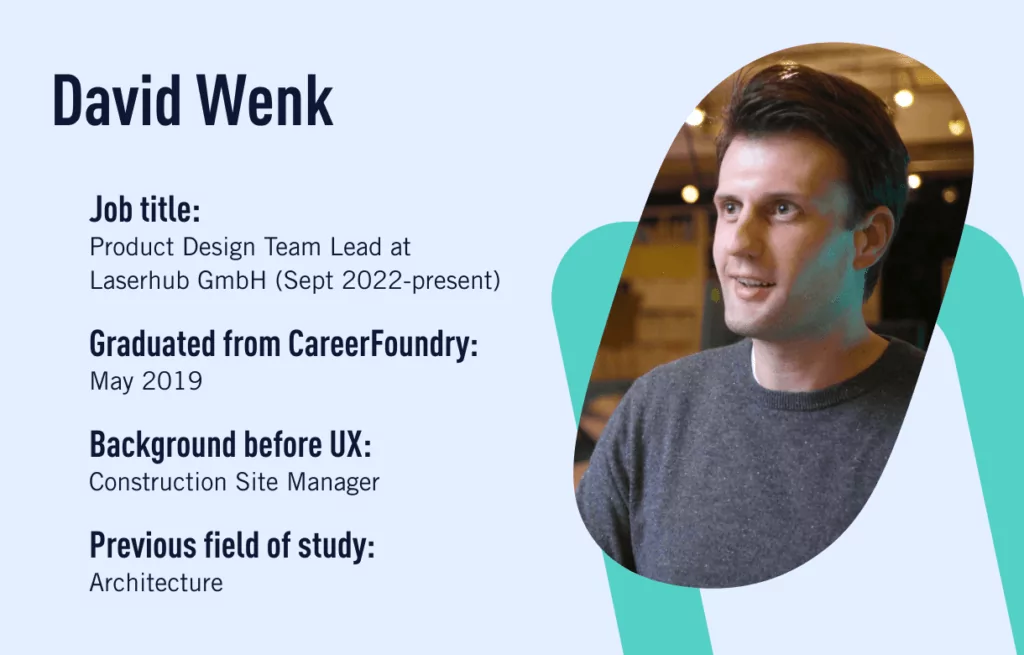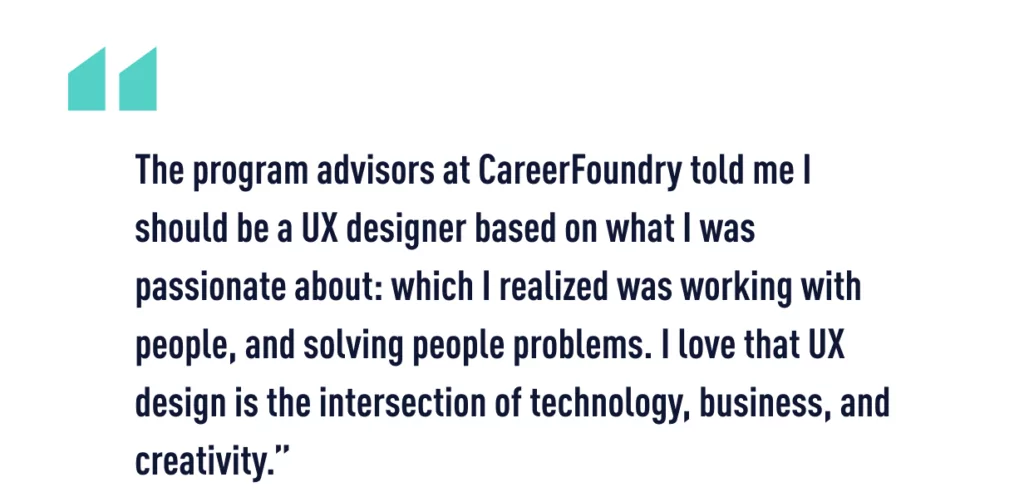
Our latest success story features UX graduate David. After completing a degree in architecture, David launched a promising career in Switzerland as a junior architect—eventually returning to his native Germany as a construction site manager.
From the outside, David had a lot going for him: a fruitful career with a bright future. But deep down, David felt that he lacked a genuine, authentic passion for his work.
“I studied architecture for five years, had a successful career, and was appreciated and respected at work. But I felt that I couldn’t bring the same passion into the job every day. Someone told me that you can only be good at something if you love what you’re doing, and when I thought about it, I realized that I just didn’t.”
Instead of letting this revelation get him down, David sprung into action—and began exploring his other interests. First on the list? Tech: a field that David had always been fascinated by.
When the opportunity arose for David to take a trip to the USA to visit a solar energy company in San Francisco, he jumped at the chance—sensing it would be his opportunity to truly get to know the industry. Little did he know, this trip would change his life forever.
“Everything that’s happening there in tech, like self-driving cars, blew my mind. Everything that we’re discussing in Europe is already taking place in America.”
Being immersed in the innovation of the tech industry gave David the awakening that he needed. He knew that this was the field he was destined to be a part of. But how would he bridge the skills gap and make this career change?
Convinced that coding skills were a prerequisite for a transition into tech, David buckled down and began teaching himself HTML and CSS. He even volunteered his newly learned coding skills to nonprofit organizations to bolster his work experience. Luckily, David’s girlfriend was working in tech at the time, and had acquired a robust network of industry professionals.
Armed with his determination to break into the industry, David started connecting with industry professionals—from product designers to UX designers.
“I learned so much about user experience design, a term I’d never heard of before. But also, I learned that so many architects become UX designers. This was so interesting.”
Discovering that a career change from architecture to UX design was actually a well-trodden path signaled to David that he was on the right track. The more research he did, the more he learned about architects who had made the transition into UX. He began to draw key parallels between the two disciplines, as they share many of the same principles. In fact, architectural design is often described as the physical and spatial version of user experience design.
Overwhelmed by the idea of learning UX entirely on his own, David set out on the hunt for a bootcamp that would afford him the time to keep his full-time job. In need of some serious guidance, CareerFoundry serendipitously appeared on his radar.
“In the beginning, I was insecure about what I wanted. I was still thinking about going into web development as I’d already been learning code. But when I spoke to the CareerFoundry program advisors, they offered me some valuable alternative advice.”

David loved the idea of studying with CareerFoundry, but wanted to take all the necessary steps to ensure that it was the right course for him. On top of his extensive networking, thorough research, and weekly interviews with UX professionals, David decided to set up a meeting with a couple of CareerFoundry UX alumni to hear firsthand about their experiences as CareerFoundry students.
To say he was blown away by the positive responses and affirmations from the alumni would be an understatement. His mind was made up.
When I quiz David on whether the course lived up to his expectations, his answer is a resounding yes. The highlight of his experience? The CareerFoundry mentors.
“They were always showing me new perspectives, pushing me to challenge myself and encouraging me to think about things differently. Every time they would suggest something that I hadn’t considered, it would reframe the task at hand in a new light. I had such a great relationship with my mentor, and I believe every student should take full advantage of that relationship.”
After graduating, David landed his first job in the industry as a UX/UI designer at Authenteq: an automated identity verification and privacy platform which enables users to verify their identity and create their own sovereign digital IDs. For David, the rewarding nature of his work was the motivation to bring his best self to the office every day.
“Authenteq is on the right side of history. When you see all these data leaks, like what happened at Facebook, privacy is such an important topic nowadays. The vision at Authenteq is inspiring.”
For the first time in years, David was excited to go to work each day. The opportunity to grow and evolve in his role, and being able to apply the design thinking process in his approach to the projects he works on being just some of the great aspects of his role.
“Time flies when I’m working, and that made me feel guilty at first! I wondered if it was normal to enjoy a job this much. But my managers and peers assured me that I was improving massively, and contributing loads to the company. They even told me their UX had improved since I joined!”
Despite flourishing in his new role, David admits it hasn’t been an easy road. Switching career paths is never easy, and can often leave you feeling inadequate, isolated, or doubtful about your credentials.
For David, knowing he would one day be in a career that he truly enjoyed was his north star. He knew that all the effort he put into networking and thorough research would be worth it. Looking back, he knows he made the right choice making a career change from architecture to UX design.
So, what advice would David give to people who are looking to make a career transition themselves?
“We have a saying in Germany: it’s dangerous to swim in your own juice. Making a major life decision without networking is pointless. Don’t be insular. No matter how daunting it may seem, it’s so important to talk to people who have had a similar experience, reach out to people on LinkedIn, and ask for advice.”
David hopes that his love of bringing clients and stakeholders together continues to provide opportunities to solve strategic challenges for his customers. But for now, one thing’s for sure; David intends to stay in UX for a very long time. His future is bright, and we wish him all the best!
Update: Since we spoke to David for this interview, he’s gone from strength-to-strength in his UX design career and has accrued some invaluable experience. He’s now leading the product design team at Laserhub and is also a CareerFoundry mentor himself!
We were lucky enough to catch up with David once again—this time in the CareerFoundry offices in Berlin, to find out how his career has progressed since graduating in 2019.
From CareerFoundry student to product design lead, David shared his story as well as giving valuable advice on the importance of transferable skills and the benefits and challenges of having a remote job in today’s workplace. Check out the video to hear directly from David:
As a CareerFoundry mentor, David has also been working with other UX design students helping them carve out their new careers in design. Check out this success story from Ophelie, one of David’s students, to learn why she is so grateful to have David as her professional mentor.
If you’re feeling motivated by David’s story and want to see if working in tech is a good choice for you too, sign up here for a free short course in the field of your choice. If you’d like some more advice about making a career change into tech, book a free call with an expert program advisor at CareerFoundry, they’ll help you figure out your next steps.
If you’re curious to find out more about other CareerFoundry graduates who made a career change from architecture to UX design, check out these success stories:
- Changing Career Paths: Ally’s Journey From Landscape Architecture to Product Design
- Alternate Jobs for Architects: How Sayma Made a Career Change to UX Design
